2023届高考英语二轮复习:词性和句子基本句子结构课件(44张ppt)
文档属性
| 名称 | 2023届高考英语二轮复习:词性和句子基本句子结构课件(44张ppt) |  | |
| 格式 | pptx | ||
| 文件大小 | 24.6MB | ||
| 资源类型 | 教案 | ||
| 版本资源 | 通用版 | ||
| 科目 | 英语 | ||
| 更新时间 | 2023-02-19 21:40:40 | ||
图片预览

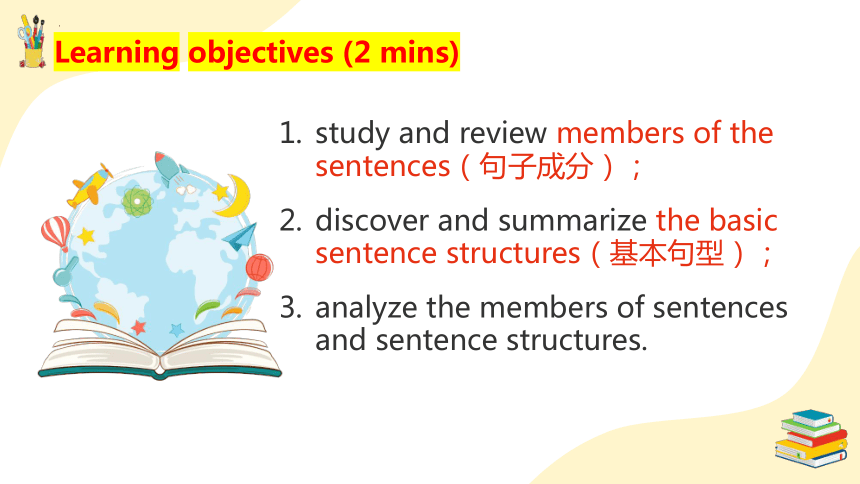
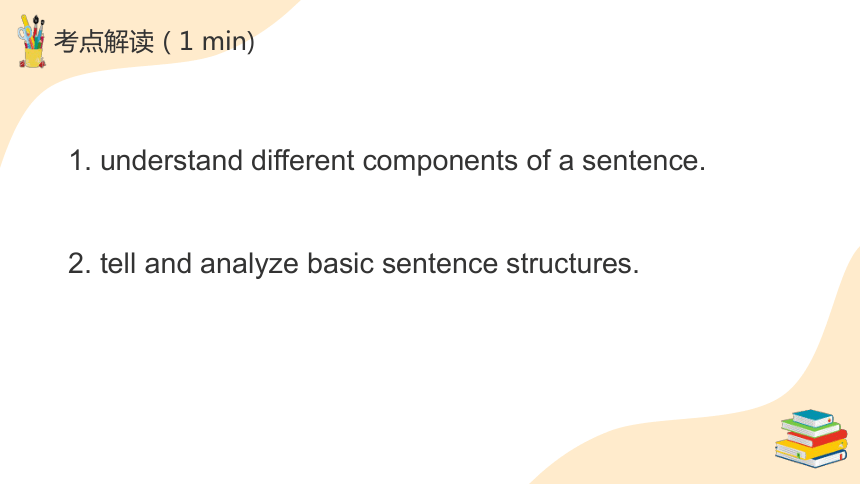
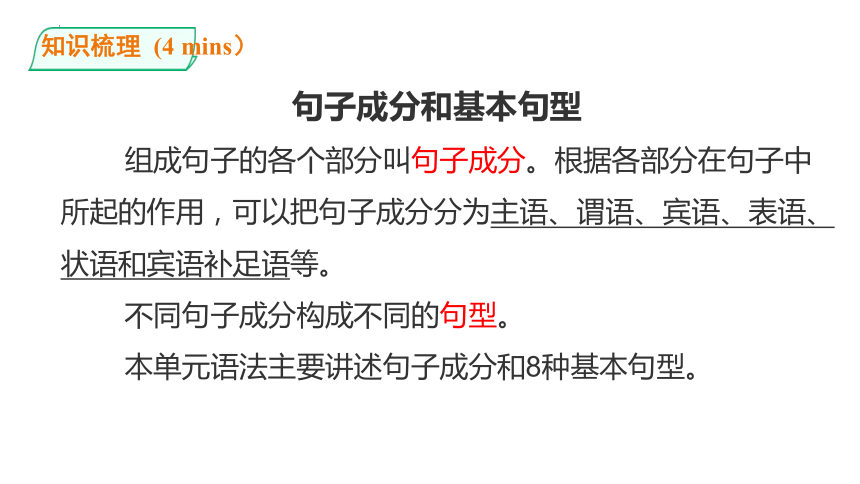
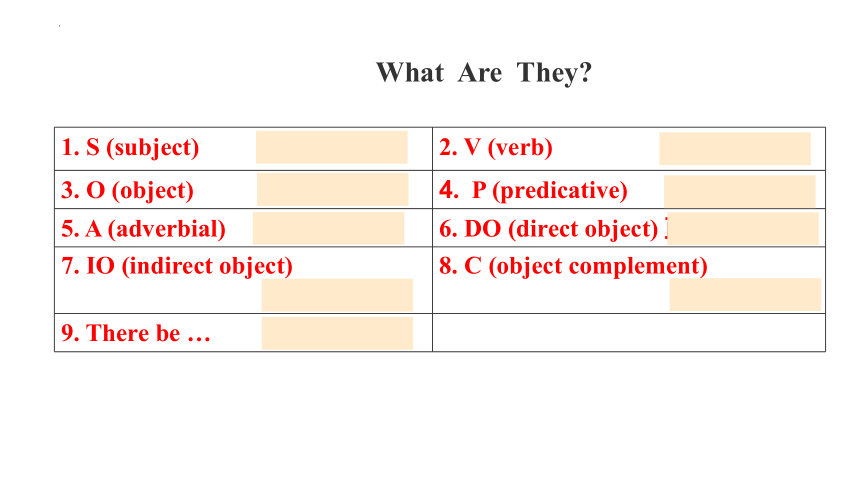
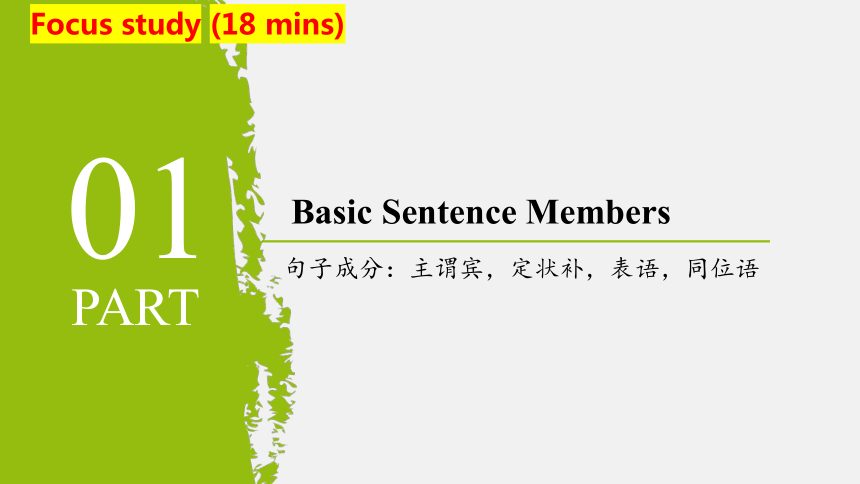

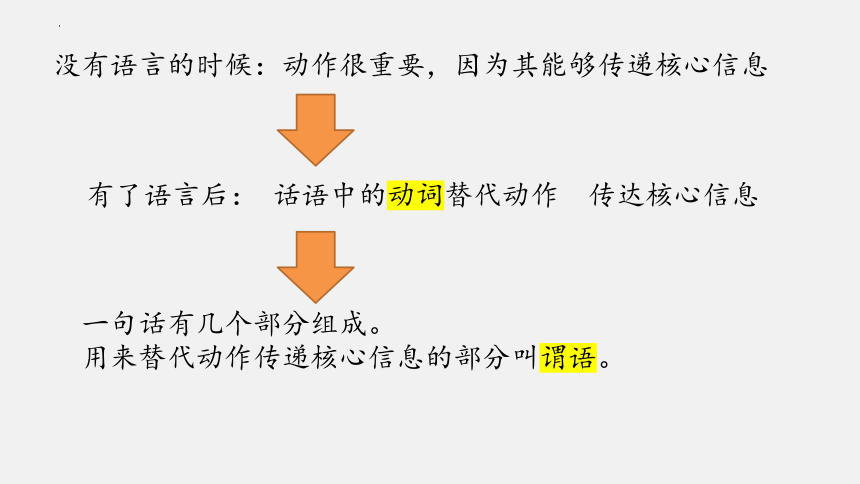
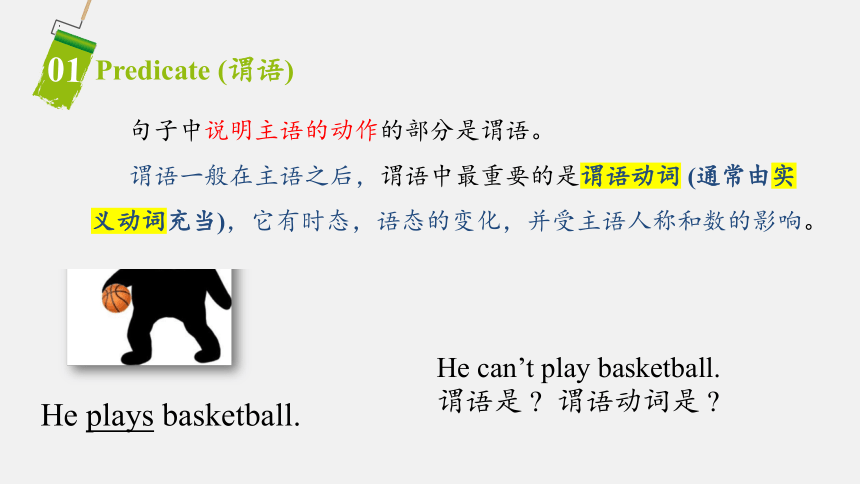
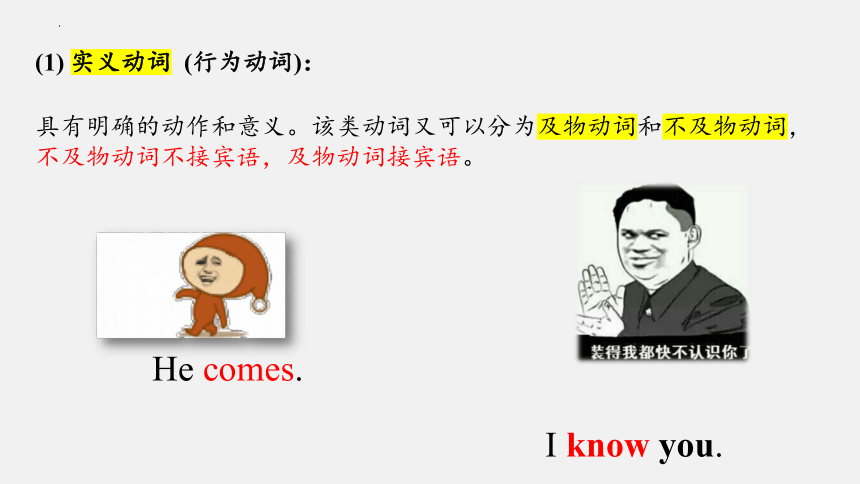
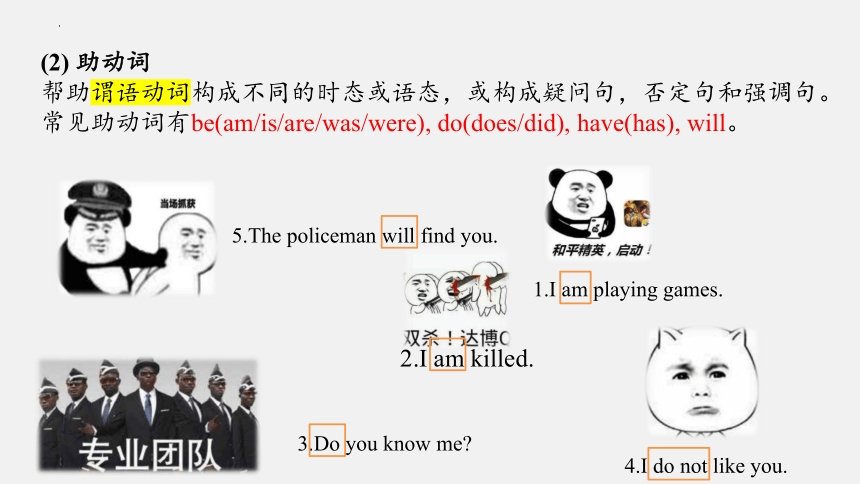
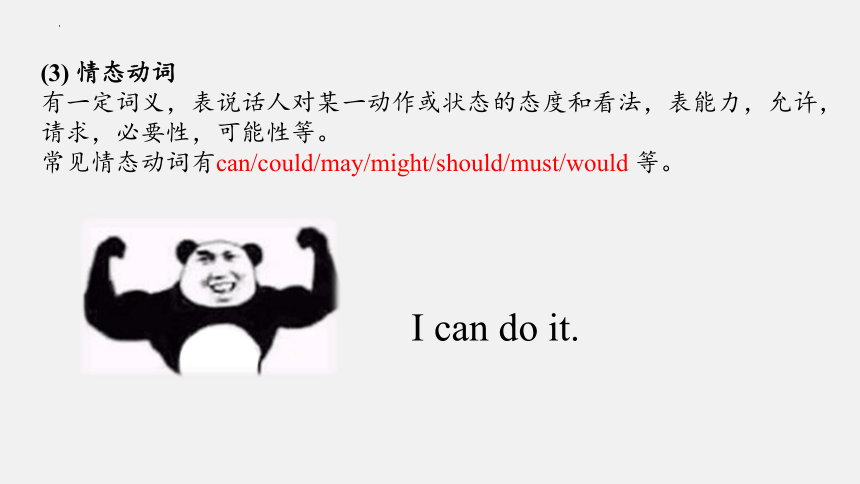
文档简介
(共44张PPT)
句子成分和基本结构
study and review members of the sentences(句子成分);
discover and summarize the basic sentence structures(基本句型);
analyze the members of sentences and sentence structures.
Learning objectives (2 mins)
考点解读(1 min)
1. understand different components of a sentence.
2. tell and analyze basic sentence structures.
句子成分和基本句型组成句子的各个部分叫句子成分。根据各部分在句子中所起的作用,可以把句子成分分为主语、谓语、宾语、表语、状语和宾语补足语等。不同句子成分构成不同的句型。本单元语法主要讲述句子成分和8种基本句型。知识梳理(4 mins)What Are They
1. S (subject) 主语 2. V (verb) 谓语动词
3. O (object) 宾语 4. P (predicative) 表语
5. A (adverbial) 状语 6. DO (direct object) 直接宾语
7. IO (indirect object) 间接宾语 8. C (object complement)
宾语补足语
9. There be … there be 结构
01
PART
Basic Sentence Members
句子成分:主谓宾,定状补,表语,同位语
Focus study (18 mins)
原始人没有语言如何交流?
动作很重要,因为能够传递重要信息。
有了语言后: 话语中的动词替代动作 传达核心信息
没有语言的时候:动作很重要,因为其能够传递核心信息
一句话有几个部分组成。
用来替代动作传递核心信息的部分叫谓语。
01
Predicate (谓语)
句子中说明主语的动作的部分是谓语。
谓语一般在主语之后,谓语中最重要的是谓语动词 (通常由实义动词充当),它有时态,语态的变化,并受主语人称和数的影响。
He plays basketball.
He can’t play basketball.
谓语是 谓语动词是
(1) 实义动词 (行为动词):
具有明确的动作和意义。该类动词又可以分为及物动词和不及物动词,不及物动词不接宾语,及物动词接宾语。
I know you.
He comes.
(2) 助动词
帮助谓语动词构成不同的时态或语态,或构成疑问句,否定句和强调句。
常见助动词有be(am/is/are/was/were), do(does/did), have(has), will。
1.I am playing games.
2.I am killed.
3.Do you know me
4.I do not like you.
5.The policeman will find you.
(3) 情态动词
有一定词义,表说话人对某一动作或状态的态度和看法,表能力,允许,请求,必要性,可能性等。
常见情态动词有can/could/may/might/should/must/would 等。
I can do it.
Subject (主语)
02
相当于句子的话题或主题,即要说明的人或物。
能用来做主语的有名词,代词,动名词,动词不定式,主语从句。
1.My hat is green.
2.Her pen is green, and mine is red.
These are my books.
Who is your brother
Everything is bad.
3.Eating apples is good.
4.To play games is cool.
5.That Jason is cool is true.
03
Object (宾语)
表谓语动词动作的承受对象,即:动作的承受着。
英语中及物动词和介词需要带宾语。
1.I like music.
2.I like to play basketball.
3.I like dancing.
4.I like you.
I like this.
5.I think that he is cool.
作宾语的成分:
名词,代词,不定式,动名词,从句。
04
Predicative (表语)
表语在句中用来说明主语的身份职业,性质特征, 状态,方向或处所等。表语在系动词之后。
1.I am a student.
2.This is my book. That is yours.
3.I am happy.
4.My dream is to be a doctor.
5.My job is teaching English.
6.The movie is interesting.
7.I am interested in the book.
8.That is why I want to stay here.
作表语的成分有:
名词,代词,形容词,不定式,动名词,分词,从句。
(2) 系动词: 起连接主语和表语作用,本身有一定词义,它和实义动词
一样有时态变化,也受主语人称和数的影响。
常见系动词:
be (am/is/are/was/were);
感官:smell, sound, taste, look, seem, feel(摸起来), appear;
变得:become/get/grow/turn/fall(变得) ;
保持:remain (仍然是) ,keep/stay;
1. The car is cool.
2. The rose smells good.
3. She is in shape.
05
Attributive (定语)
修饰名词或代词的词,短语或句子叫定语。定语可前置也可后置。单个的单词作定语时,习惯上放在被修饰词之前作前置定语;短语或定语从句作定语时,习惯上作后置定语。
1.A beautiful girl comes.
2.I like the apple tree.
3.The boy in the room is my friend.
4.I go to the reading room.
5.I am the first student to come to the classroom.
修饰名词或代词的词,短语或句子叫定语。定语可前置也可后置。单个的单词作定语时,习惯上放在被修饰词之前作前置定语;短语或定语从句作定语时,习惯上作后置定语。
1.A beautiful girl comes.
2.I like the apple tree.
3.The boy in the room is my friend.
4.I go to the reading room.
5.I am the first student to come to the classroom.
6.A broken heart.
7.An interesting book.
8.I know a boy called Tom.
9.The car running in the playground is my uncle’s car.
10.I know the boy who broke the window yesterday.
可作定语的有:
名词,形容词,介词短语,分词(短语) ,不定式,动名词,定语从句。
6.A broken heart.
7.An interesting book.
8.I know a boy called Tom.
9.The car running in the playground is my uncle’s car.
10.I know the boy who broke the window yesterday.
06
Adverbial (状语)
修饰动词,形容词,副词或整个句子的词,短语或从句(状语从句)叫状语。状语表示时间,地点,目的,原因,结果,条件,让步,程度,方式及伴随等。
1.He plays the guitar well.
2.Luckily, he won the game.
3.I am very happy.
4.He works hard to make money.
5.I can’t go there.
6.In Wuhan, many people can’t go out.
7.Although I don’t have money, I still want to buy that book.
8.When I have time , I will go shopping with you.
9.I didn’t go to school because I was ill.
10. If it rains tomorrow, we will stay at home.
能作状语的有:副词,介词短语,分词(短语),不定式,状语从句。
修饰动词,形容词,副词或整个句子的词,短语或从句(状语从句)叫状语。状语表示时间,地点,目的,原因,结果,条件,让步,程度,方式及伴随等。
1.He plays the guitar well.
2.Luckily, he won the game.
3.I am very happy.
4.He works hard to make money.
5.I can’t go there.
6.In Wuhan, many people can’t go out.
7.Although I don’t have money, I still want to buy that book.
8.When I have time , I will go shopping with you.
9.I didn’t go to school because I was ill.
10. If it rains tomorrow, we will stay at home.
能作状语的有:副词,介词短语,分词(短语),不定式,状语从句。
07
Complement (补语)
英语中,一些及物动词的宾语后要加上一个补语,对宾语作进一步的补充说明,意思才够完整和明确。该补语被称为宾补。
使役动词 “make+宾语+宾补”
名词/代词
名词/形容词/省掉to的不定式/过去分词
1.We make our enemies our friends.
2.You make me happy.
3.You made me laugh.
4.I spoke slowly to make myself understood.
1.We make our enemies our friends.
2.You make me happy.
3.You made me laugh.
4.I spoke slowly to make myself understood.
08
Appositive (同位语)
跟在抽象名词后面,对该抽象名词作进一步解释,说明的成分。
常用来作同位语的有:名词,数词,不定代词 (all, each , both), 同位语从句。
1. XG , a senior high school, is good.
2.We four like the teacher.
3.We all like XG.
4.I know the fact that XG is good.
Basic Sentence Patterns
八大基本句型结构
02
PART
主谓 (SV)
01
这一类型的谓语动词通常是不及物动词,
不需要带宾语就能把意思说明白。
The bus comes.
The bus leaves.
主谓+状语 (SVA)
02
在主谓的基础上加上时间、地点、原因、条件、方式等。
He left in the morning.
He didn’t come back until midnight.
He runs quickly.
状语
He left in the morning.
He didn’t come back until midnight.
He runs quickly.
主谓宾 (SVO)
03
此时,谓语动词是及物动词,必须带宾语,才能把话说明白。
I have a friend.
I want to travel.
主谓宾+状语 (SVOA)
04
在主谓宾句型的基础上补充时间,地点,原因,条件,方式等信息。
I have my first class at senior high school.
They met each other when they were young.
状语
I have my first class at senior high school.
They met each other when they were young.
主系表 (SP)
05
常见系动词:
be(am/is/are/was/were);
感官动词:smell, sound, taste, look, seem, feel(摸起来), appear;
变得:become/get/grow/turn/fall;
保持:remain(仍然是),keep/stay;
3. The rose smells good.
1. The car is cool.
2. They remained best friends.
主+谓+间宾+直宾 (SV IO DO)
06
人
物
此时,谓语动词常为:
give, bring, tell, send, leave(留), pass(传递), write, take, show, teach, get(给某人弄到某物), award (授予), lend, rent(租), buy, pay, hand(递给) + sb + sth .
She gives me her WeChat ID.
Lend me some money !
主谓宾+宾补 (SVOC)
07
有些及物动词加了宾语,但是意思还是没有说完整,此时还得在宾语后面再加一个宾补对宾语进行不充说明。
常见带宾补的动词:feel, find, get, have, make, leave, let, keep, call, think等。
The news makes the mother happy.
There be …
08
该句型可以表示“某地有(存在)某物”,
或当我们不知道是谁有……时,也可用该句型。
There are many students in a school.
There is no need for me to wait here.
Summary
In this period, we’ve learned about some important concepts of syntax.
The definitions of S, V, O, P, A, DO, IO, C;
Eight basic sentence structures.
6.当堂训练 (10 mins)
1. A girl got lost.
2. Her school was huge.
3.There were kids everywhere.
4.Her class started.
5. She went to a class in a hurry.
6. She found her teacher friendly.
7. She went to a wrong class.
8. They laughed too much.
9. The administrator gave her a big hand.
10. She found her class.
a:S V b:S +V +O c:S +V-link +P
d: S +V +IO +DO e: S +V +O +C f: S +V+A
g: S +V +O +A. h: there be
1. A girl got lost.
2. Her school was huge.
3.There were kids everywhere.
4.Her class started.
5. She went to a class in a hurry.
6. She found her teacher friendly.
7. She went to a wrong class.
8. They laughed too much.
9. The administrator gave her a big hand.
10. She found her class.
c
c
a
g
e
b
f
d
h
b
1. The 100-year-old school lies in the center of the city.
2. We must act.
3. The maths homework looks easy.
4. The teacher found the classroom empty.
5. My mum bought me a new dictionary.
6. Tom is looking forward to meeting the new exchange student.
7. We had chemistry in the newly built lab.
1.读句子分析划线句子的句型(P6).
1 The 100-year-old school lies in the centre of
the city.
2 We must act..
3 The maths homework looks easy.
4 The teacher found the classroom empty.
S
V
A
S
V
S
V
P
S
V
O
C
Answer
5 My mum bought me a new dictionary.
6 Tom is looking forward to meeting the new
exchange student.
7 There is an English Corner at our school.
8 We had chemistry in the newly built lab.
S
V
IO
DO
S
V
O
There be ......
S
V
O
A
Homework
Get familiar with S, V, O, P, A, DO, IO, C.
Master eight basic sentence patterns.
Finish Ex .
英语句式
简单句
并列句
复合句
只含有一个主谓结构的句子
英语句式
简单句
并列句
复合句
由并列连词把两个或两个以上的简单句连在一起的句子叫并列句
He helps me and I help him.
Hurry up, or you’ll be late.
I offered to help him, but he refused.
4. He went to school yesterday though he was ill.
例:
He helps me and I help him.
Hurry up, or you’ll be late.
I offered to help him, but he refused.
4. He went to school yesterday though he was ill.
并列句中的各简单句意义同等重要,
是平行并列的关系。
英语句式
简单句
并列句
复合句
一个主句+ 从句
I really feel she’s making a mistake.
我真的感觉她正在犯错误。
It is true that the man on the left is a well-known writer here.
左边那个人是本地的一位著名作家,这是真的。
They have no idea at all where he has gone.
他们根本不知道他去哪儿了。
China is no longer what she used to be.
今日的中国不再是过去的中国了。
The girl (who/whom) we met yesterday is Li Lei’s sister.
昨天我们碰到的那个女孩是李雷的妹妹。
He is a professor, which I have been looking forward to becoming.
他是个教授,那是我一直期盼的职业。
He has worked in that company since he graduated from Beijing University.
他从北大毕业以来就一直在那家公司工作。
句子成分和基本结构
study and review members of the sentences(句子成分);
discover and summarize the basic sentence structures(基本句型);
analyze the members of sentences and sentence structures.
Learning objectives (2 mins)
考点解读(1 min)
1. understand different components of a sentence.
2. tell and analyze basic sentence structures.
句子成分和基本句型组成句子的各个部分叫句子成分。根据各部分在句子中所起的作用,可以把句子成分分为主语、谓语、宾语、表语、状语和宾语补足语等。不同句子成分构成不同的句型。本单元语法主要讲述句子成分和8种基本句型。知识梳理(4 mins)What Are They
1. S (subject) 主语 2. V (verb) 谓语动词
3. O (object) 宾语 4. P (predicative) 表语
5. A (adverbial) 状语 6. DO (direct object) 直接宾语
7. IO (indirect object) 间接宾语 8. C (object complement)
宾语补足语
9. There be … there be 结构
01
PART
Basic Sentence Members
句子成分:主谓宾,定状补,表语,同位语
Focus study (18 mins)
原始人没有语言如何交流?
动作很重要,因为能够传递重要信息。
有了语言后: 话语中的动词替代动作 传达核心信息
没有语言的时候:动作很重要,因为其能够传递核心信息
一句话有几个部分组成。
用来替代动作传递核心信息的部分叫谓语。
01
Predicate (谓语)
句子中说明主语的动作的部分是谓语。
谓语一般在主语之后,谓语中最重要的是谓语动词 (通常由实义动词充当),它有时态,语态的变化,并受主语人称和数的影响。
He plays basketball.
He can’t play basketball.
谓语是 谓语动词是
(1) 实义动词 (行为动词):
具有明确的动作和意义。该类动词又可以分为及物动词和不及物动词,不及物动词不接宾语,及物动词接宾语。
I know you.
He comes.
(2) 助动词
帮助谓语动词构成不同的时态或语态,或构成疑问句,否定句和强调句。
常见助动词有be(am/is/are/was/were), do(does/did), have(has), will。
1.I am playing games.
2.I am killed.
3.Do you know me
4.I do not like you.
5.The policeman will find you.
(3) 情态动词
有一定词义,表说话人对某一动作或状态的态度和看法,表能力,允许,请求,必要性,可能性等。
常见情态动词有can/could/may/might/should/must/would 等。
I can do it.
Subject (主语)
02
相当于句子的话题或主题,即要说明的人或物。
能用来做主语的有名词,代词,动名词,动词不定式,主语从句。
1.My hat is green.
2.Her pen is green, and mine is red.
These are my books.
Who is your brother
Everything is bad.
3.Eating apples is good.
4.To play games is cool.
5.That Jason is cool is true.
03
Object (宾语)
表谓语动词动作的承受对象,即:动作的承受着。
英语中及物动词和介词需要带宾语。
1.I like music.
2.I like to play basketball.
3.I like dancing.
4.I like you.
I like this.
5.I think that he is cool.
作宾语的成分:
名词,代词,不定式,动名词,从句。
04
Predicative (表语)
表语在句中用来说明主语的身份职业,性质特征, 状态,方向或处所等。表语在系动词之后。
1.I am a student.
2.This is my book. That is yours.
3.I am happy.
4.My dream is to be a doctor.
5.My job is teaching English.
6.The movie is interesting.
7.I am interested in the book.
8.That is why I want to stay here.
作表语的成分有:
名词,代词,形容词,不定式,动名词,分词,从句。
(2) 系动词: 起连接主语和表语作用,本身有一定词义,它和实义动词
一样有时态变化,也受主语人称和数的影响。
常见系动词:
be (am/is/are/was/were);
感官:smell, sound, taste, look, seem, feel(摸起来), appear;
变得:become/get/grow/turn/fall(变得) ;
保持:remain (仍然是) ,keep/stay;
1. The car is cool.
2. The rose smells good.
3. She is in shape.
05
Attributive (定语)
修饰名词或代词的词,短语或句子叫定语。定语可前置也可后置。单个的单词作定语时,习惯上放在被修饰词之前作前置定语;短语或定语从句作定语时,习惯上作后置定语。
1.A beautiful girl comes.
2.I like the apple tree.
3.The boy in the room is my friend.
4.I go to the reading room.
5.I am the first student to come to the classroom.
修饰名词或代词的词,短语或句子叫定语。定语可前置也可后置。单个的单词作定语时,习惯上放在被修饰词之前作前置定语;短语或定语从句作定语时,习惯上作后置定语。
1.A beautiful girl comes.
2.I like the apple tree.
3.The boy in the room is my friend.
4.I go to the reading room.
5.I am the first student to come to the classroom.
6.A broken heart.
7.An interesting book.
8.I know a boy called Tom.
9.The car running in the playground is my uncle’s car.
10.I know the boy who broke the window yesterday.
可作定语的有:
名词,形容词,介词短语,分词(短语) ,不定式,动名词,定语从句。
6.A broken heart.
7.An interesting book.
8.I know a boy called Tom.
9.The car running in the playground is my uncle’s car.
10.I know the boy who broke the window yesterday.
06
Adverbial (状语)
修饰动词,形容词,副词或整个句子的词,短语或从句(状语从句)叫状语。状语表示时间,地点,目的,原因,结果,条件,让步,程度,方式及伴随等。
1.He plays the guitar well.
2.Luckily, he won the game.
3.I am very happy.
4.He works hard to make money.
5.I can’t go there.
6.In Wuhan, many people can’t go out.
7.Although I don’t have money, I still want to buy that book.
8.When I have time , I will go shopping with you.
9.I didn’t go to school because I was ill.
10. If it rains tomorrow, we will stay at home.
能作状语的有:副词,介词短语,分词(短语),不定式,状语从句。
修饰动词,形容词,副词或整个句子的词,短语或从句(状语从句)叫状语。状语表示时间,地点,目的,原因,结果,条件,让步,程度,方式及伴随等。
1.He plays the guitar well.
2.Luckily, he won the game.
3.I am very happy.
4.He works hard to make money.
5.I can’t go there.
6.In Wuhan, many people can’t go out.
7.Although I don’t have money, I still want to buy that book.
8.When I have time , I will go shopping with you.
9.I didn’t go to school because I was ill.
10. If it rains tomorrow, we will stay at home.
能作状语的有:副词,介词短语,分词(短语),不定式,状语从句。
07
Complement (补语)
英语中,一些及物动词的宾语后要加上一个补语,对宾语作进一步的补充说明,意思才够完整和明确。该补语被称为宾补。
使役动词 “make+宾语+宾补”
名词/代词
名词/形容词/省掉to的不定式/过去分词
1.We make our enemies our friends.
2.You make me happy.
3.You made me laugh.
4.I spoke slowly to make myself understood.
1.We make our enemies our friends.
2.You make me happy.
3.You made me laugh.
4.I spoke slowly to make myself understood.
08
Appositive (同位语)
跟在抽象名词后面,对该抽象名词作进一步解释,说明的成分。
常用来作同位语的有:名词,数词,不定代词 (all, each , both), 同位语从句。
1. XG , a senior high school, is good.
2.We four like the teacher.
3.We all like XG.
4.I know the fact that XG is good.
Basic Sentence Patterns
八大基本句型结构
02
PART
主谓 (SV)
01
这一类型的谓语动词通常是不及物动词,
不需要带宾语就能把意思说明白。
The bus comes.
The bus leaves.
主谓+状语 (SVA)
02
在主谓的基础上加上时间、地点、原因、条件、方式等。
He left in the morning.
He didn’t come back until midnight.
He runs quickly.
状语
He left in the morning.
He didn’t come back until midnight.
He runs quickly.
主谓宾 (SVO)
03
此时,谓语动词是及物动词,必须带宾语,才能把话说明白。
I have a friend.
I want to travel.
主谓宾+状语 (SVOA)
04
在主谓宾句型的基础上补充时间,地点,原因,条件,方式等信息。
I have my first class at senior high school.
They met each other when they were young.
状语
I have my first class at senior high school.
They met each other when they were young.
主系表 (SP)
05
常见系动词:
be(am/is/are/was/were);
感官动词:smell, sound, taste, look, seem, feel(摸起来), appear;
变得:become/get/grow/turn/fall;
保持:remain(仍然是),keep/stay;
3. The rose smells good.
1. The car is cool.
2. They remained best friends.
主+谓+间宾+直宾 (SV IO DO)
06
人
物
此时,谓语动词常为:
give, bring, tell, send, leave(留), pass(传递), write, take, show, teach, get(给某人弄到某物), award (授予), lend, rent(租), buy, pay, hand(递给) + sb + sth .
She gives me her WeChat ID.
Lend me some money !
主谓宾+宾补 (SVOC)
07
有些及物动词加了宾语,但是意思还是没有说完整,此时还得在宾语后面再加一个宾补对宾语进行不充说明。
常见带宾补的动词:feel, find, get, have, make, leave, let, keep, call, think等。
The news makes the mother happy.
There be …
08
该句型可以表示“某地有(存在)某物”,
或当我们不知道是谁有……时,也可用该句型。
There are many students in a school.
There is no need for me to wait here.
Summary
In this period, we’ve learned about some important concepts of syntax.
The definitions of S, V, O, P, A, DO, IO, C;
Eight basic sentence structures.
6.当堂训练 (10 mins)
1. A girl got lost.
2. Her school was huge.
3.There were kids everywhere.
4.Her class started.
5. She went to a class in a hurry.
6. She found her teacher friendly.
7. She went to a wrong class.
8. They laughed too much.
9. The administrator gave her a big hand.
10. She found her class.
a:S V b:S +V +O c:S +V-link +P
d: S +V +IO +DO e: S +V +O +C f: S +V+A
g: S +V +O +A. h: there be
1. A girl got lost.
2. Her school was huge.
3.There were kids everywhere.
4.Her class started.
5. She went to a class in a hurry.
6. She found her teacher friendly.
7. She went to a wrong class.
8. They laughed too much.
9. The administrator gave her a big hand.
10. She found her class.
c
c
a
g
e
b
f
d
h
b
1. The 100-year-old school lies in the center of the city.
2. We must act.
3. The maths homework looks easy.
4. The teacher found the classroom empty.
5. My mum bought me a new dictionary.
6. Tom is looking forward to meeting the new exchange student.
7. We had chemistry in the newly built lab.
1.读句子分析划线句子的句型(P6).
1 The 100-year-old school lies in the centre of
the city.
2 We must act..
3 The maths homework looks easy.
4 The teacher found the classroom empty.
S
V
A
S
V
S
V
P
S
V
O
C
Answer
5 My mum bought me a new dictionary.
6 Tom is looking forward to meeting the new
exchange student.
7 There is an English Corner at our school.
8 We had chemistry in the newly built lab.
S
V
IO
DO
S
V
O
There be ......
S
V
O
A
Homework
Get familiar with S, V, O, P, A, DO, IO, C.
Master eight basic sentence patterns.
Finish Ex .
英语句式
简单句
并列句
复合句
只含有一个主谓结构的句子
英语句式
简单句
并列句
复合句
由并列连词把两个或两个以上的简单句连在一起的句子叫并列句
He helps me and I help him.
Hurry up, or you’ll be late.
I offered to help him, but he refused.
4. He went to school yesterday though he was ill.
例:
He helps me and I help him.
Hurry up, or you’ll be late.
I offered to help him, but he refused.
4. He went to school yesterday though he was ill.
并列句中的各简单句意义同等重要,
是平行并列的关系。
英语句式
简单句
并列句
复合句
一个主句+ 从句
I really feel she’s making a mistake.
我真的感觉她正在犯错误。
It is true that the man on the left is a well-known writer here.
左边那个人是本地的一位著名作家,这是真的。
They have no idea at all where he has gone.
他们根本不知道他去哪儿了。
China is no longer what she used to be.
今日的中国不再是过去的中国了。
The girl (who/whom) we met yesterday is Li Lei’s sister.
昨天我们碰到的那个女孩是李雷的妹妹。
He is a professor, which I have been looking forward to becoming.
他是个教授,那是我一直期盼的职业。
He has worked in that company since he graduated from Beijing University.
他从北大毕业以来就一直在那家公司工作。
